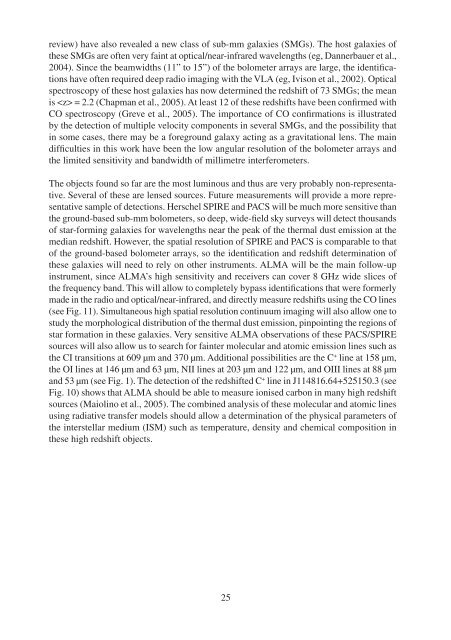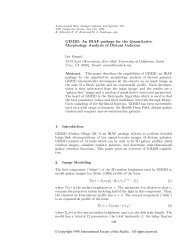4 Comparison of the ALMA and Herschel - ESO
4 Comparison of the ALMA and Herschel - ESO
4 Comparison of the ALMA and Herschel - ESO
Create successful ePaper yourself
Turn your PDF publications into a flip-book with our unique Google optimized e-Paper software.
eview) have also revealed a new class <strong>of</strong> sub-mm galaxies (SMGs). The host galaxies <strong>of</strong><br />
<strong>the</strong>se SMGs are <strong>of</strong>ten very faint at optical/near-infrared wavelengths (eg, Dannerbauer et al.,<br />
2004). Since <strong>the</strong> beamwidths (11” to 15”) <strong>of</strong> <strong>the</strong> bolometer arrays are large, <strong>the</strong> identifications<br />
have <strong>of</strong>ten required deep radio imaging with <strong>the</strong> VLA (eg, Ivison et al., 2002). Optical<br />
spectroscopy <strong>of</strong> <strong>the</strong>se host galaxies has now determined <strong>the</strong> redshift <strong>of</strong> 73 SMGs; <strong>the</strong> mean<br />
is = 2.2 (Chapman et al., 2005). At least 12 <strong>of</strong> <strong>the</strong>se redshifts have been confirmed with<br />
CO spectroscopy (Greve et al., 2005). The importance <strong>of</strong> CO confirmations is illustrated<br />
by <strong>the</strong> detection <strong>of</strong> multiple velocity components in several SMGs, <strong>and</strong> <strong>the</strong> possibility that<br />
in some cases, <strong>the</strong>re may be a foreground galaxy acting as a gravitational lens. The main<br />
difficulties in this work have been <strong>the</strong> low angular resolution <strong>of</strong> <strong>the</strong> bolometer arrays <strong>and</strong><br />
<strong>the</strong> limited sensitivity <strong>and</strong> b<strong>and</strong>width <strong>of</strong> millimetre interferometers.<br />
The objects found so far are <strong>the</strong> most luminous <strong>and</strong> thus are very probably non-representative.<br />
Several <strong>of</strong> <strong>the</strong>se are lensed sources. Future measurements will provide a more representative<br />
sample <strong>of</strong> detections. <strong>Herschel</strong> SPIRE <strong>and</strong> PACS will be much more sensitive than<br />
<strong>the</strong> ground-based sub-mm bolometers, so deep, wide-field sky surveys will detect thous<strong>and</strong>s<br />
<strong>of</strong> star-forming galaxies for wavelengths near <strong>the</strong> peak <strong>of</strong> <strong>the</strong> <strong>the</strong>rmal dust emission at <strong>the</strong><br />
median redshift. However, <strong>the</strong> spatial resolution <strong>of</strong> SPIRE <strong>and</strong> PACS is comparable to that<br />
<strong>of</strong> <strong>the</strong> ground-based bolometer arrays, so <strong>the</strong> identification <strong>and</strong> redshift determination <strong>of</strong><br />
<strong>the</strong>se galaxies will need to rely on o<strong>the</strong>r instruments. <strong>ALMA</strong> will be <strong>the</strong> main follow-up<br />
instrument, since <strong>ALMA</strong>’s high sensitivity <strong>and</strong> receivers can cover 8 GHz wide slices <strong>of</strong><br />
<strong>the</strong> frequency b<strong>and</strong>. This will allow to completely bypass identifications that were formerly<br />
made in <strong>the</strong> radio <strong>and</strong> optical/near-infrared, <strong>and</strong> directly measure redshifts using <strong>the</strong> CO lines<br />
(see Fig. 11). Simultaneous high spatial resolution continuum imaging will also allow one to<br />
study <strong>the</strong> morphological distribution <strong>of</strong> <strong>the</strong> <strong>the</strong>rmal dust emission, pinpointing <strong>the</strong> regions <strong>of</strong><br />
star formation in <strong>the</strong>se galaxies. Very sensitive <strong>ALMA</strong> observations <strong>of</strong> <strong>the</strong>se PACS/SPIRE<br />
sources will also allow us to search for fainter molecular <strong>and</strong> atomic emission lines such as<br />
<strong>the</strong> CI transitions at 609 µm <strong>and</strong> 370 µm. Additional possibilities are <strong>the</strong> C + line at 158 µm,<br />
<strong>the</strong> OI lines at 146 µm <strong>and</strong> 63 µm, NII lines at 203 µm <strong>and</strong> 122 µm, <strong>and</strong> OIII lines at 88 µm<br />
<strong>and</strong> 53 µm (see Fig. 1). The detection <strong>of</strong> <strong>the</strong> redshifted C + line in J114816.64+525150.3 (see<br />
Fig. 10) shows that <strong>ALMA</strong> should be able to measure ionised carbon in many high redshift<br />
sources (Maiolino et al., 2005). The combined analysis <strong>of</strong> <strong>the</strong>se molecular <strong>and</strong> atomic lines<br />
using radiative transfer models should allow a determination <strong>of</strong> <strong>the</strong> physical parameters <strong>of</strong><br />
<strong>the</strong> interstellar medium (ISM) such as temperature, density <strong>and</strong> chemical composition in<br />
<strong>the</strong>se high redshift objects.<br />
25




